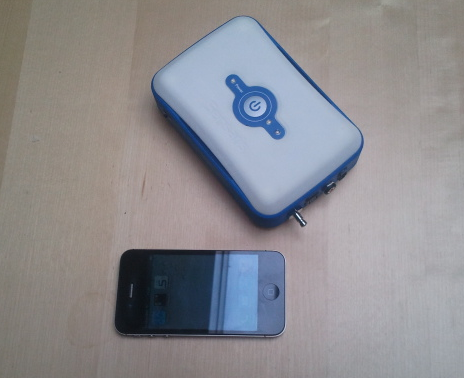
The device is small and light (310 grams).
For field use, there is also an option for a special lightweight backpack with built-in flexible solar cells which can recharge both the Zao and the mobile phone.
For cost reasons and availability of devices in the field, Zao was developed to work with basic Nokia phones and sub $100 Android based handsets, but it is compatible with 95% of the smartphones on the market today. Field use enabled fine-tuning of the software based on user input for ease of use and integration with other software systems such as Electronic Health Records or social networking applications.
Zao was also field tested in Punjab, India, by eHealthPoint Services India (HPI). HPI has E Health Points (EHP) throughout India that provide families in rural villages with clean drinking water, medicines, diagnostic tools and telemedicine. The EHP is a sustainable social business model with high economic returns for the community it serves.
Village Health Workers (VHWs) at EHPs could use the Zao to take readings from patients in these rural areas easily and efficiently. The small size, ease of use and ruggedness are critical for telemedicine application. Patients also say that instead of learning to operate a variety of devices, they wanted a simple to use, reliable unit that was compatible with their phones, internet gateways or TVs.
While field-testing Zao in Punjab, it was interesting to note that the VHWs would use one tool at a time, during different visits to the homes, so they could have a new tool to approach houses with. After a clinic session, the VHWs realized that the combination of the blood pressure, oxymeter, and thermometer tools was a great precursor to the diabetes test.
The VHWs felt that the screening questions asked re: diabetes were not enough to give the patient a sense that they were not at risk (the patients didn’t trust the information), and that testing with the other instruments allowed the VHW to inform the patient she didn’t need a glucose test (if that was the case) with more confidence. Therefore, the plan was to use all tools at one time, so that even if a patient didn’t require a glucose test (which is the most expensive re: cost), the patient still trusted the information due to the use of other technologies.”
The Zao study is still going on, but preliminary results are good. More results are due in shortly and the entire study is to be presented at the mHealth Summit meeting in Washington DC this December.
The video below shows some of the great benefits that eHealth Points has provided to the rural population of India:
To read other posts in this exclusive ongoing series, please visit the Mobile Health Around the Globe main page.
And if you have a Mobile Health Around the Globe story to tell, please email me at joan@socialmediatoday.com
And also…Register for our exclusive mHealth Webinar on May 23rd at 1pm!

